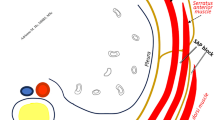Abstract
Background
Bleeding pelvic fracture patients with severe associated injuries have a high mortality rate that is exacerbated by several factors. To gain deeper etiological insights into this injury, we investigated the specific risk factors associated with the high mortality rate.
Methods
A total of 102 bleeding pelvic fracture patients with severe associated injuries (abbreviated injury score ≥3) were treated at our level I trauma center between January 1994 and December 2004. Predictors of death within 24 h of arrival were determined by univariate and multivariate analyses using anatomic and physiologic parameters, including injured body part, shock symptoms, age, sex, injury severity score (ISS), and fracture type.
Results
Overall, 47 of the 102 patients died within 24 h of arrival. Hemorrhage shock was responsible for the majority of deaths (47%). Other causes included central nervous system injury (21%), multiple injuries (central nervous system injury plus shock, 18%) and multiple organ failures (7%). Univariate analyses revealed that patients presenting with head and neck injuries and shock symptoms on arrival were associated with an increased risk of death (P < 0.01 for both variables). Multivariate analyses revealed that these injuries and shock symptoms were independently associated with a higher risk of death (odds ratios of 2.704 and 4.632, respectively). The mechanism of injury, fracture type, age, sex, and ISS were not associated with an increased risk of death.
Conclusions
Statistically significant risk factors were brain injuries and shock symptoms on arrival. Brain injuries should be heavily weighted when evaluating the prognosis of bleeding pelvic fracture patients.
Similar content being viewed by others
References
Heetveld MJ, Harris I, Schlaphoff G, Balogh Z, D’Amours SK, Sugrue M. Hemodynamically unstable pelvic fractures: recent care and new guidelines. World J Surg 2004;28:904–909.
McMurtry R, Walton D, Dickinson D, Kellam J, Tile M. Pelvic disruption in the polytraumatized patient: a management protocol. Clin Orthop 1980;151:22–30.
Panetta T, Sclafani SJ, Goldstein AS, Phillips TF, Shaftan GW. Percutaneous transcatheter embolization for massive bleeding from pelvic fractures. J Trauma 1985;25:1021–1029.
Moreno C, Moore EE, Rosenberger A, Cleveland HC. Hemorrhage associated with major pelvic fracture: a multispecialty challenge. J Trauma 1986;26:987–994.
Eastridge BJ, Starr A, Minei JP, O’Keefe GE, Scalea TM. The importance of fracture pattern in guiding therapeutic decision-making in patients with hemorrhagic shock and pelvic ring disruptions. J Trauma 2002;53:446–450.
Ben-Menachem Y, Coldwell DM, Young JW, Burgess AR. Hemorrhage associated with pelvic fractures: causes, diagnosis, and emergent management. AJR Am J Roentgenol 1991;157:1005–1014.
Mucha P Jr, Farnell MB. Analysis of pelvic fracture management. J Trauma 1984;24:379–386.
Starr AJ, Griffin DR, Reinert CM, Frawley WH, Walker J, Whitlock SN, et al. Pelvic ring disruptions: prediction of associated injuries, transfusion requirement, pelvic arteriography, complications, and mortality. J Orthop Trauma 2002;16:553–561.
Gilliland MD, Ward RE, Barton RM, Miller PW, Duke JH. Factors affecting mortality in pelvic fractures. J Trauma 1982;22:691–693.
Rittmeister M, Lindsey RW, Kohl HW III. Pelvic fracture among polytrauma decedents. Trauma-based mortality with pelvic fracture — a case series of 74 patients. Arch Orthop Trauma Surg 2001;121:43–49.
Allen CF, Goslar PW, Barry M, Christiansen T. Management guidelines for hypotensive pelvic fracture patients. Am Surg 2000;66:735–738.
Hagiwara A, Minakawa K, Fukushima H, Murata A, Masuda H, Shimazaki S. Predictors of death in patients with life-threatening pelvic hemorrhage after successful transcatheter arterial embolization. J Trauma 2003;55:696–703.
Miller PR, Moore PS, Mansell E, Meredith JW, Chang MC. External fixation or arteriogram in bleeding pelvic fracture: initial therapy guided by markers of arterial hemorrhage. J Trauma 2003;54:437–443.
Gylling SF, Ward RE, Holcroft JW, Bray TJ, Chapman MW. Immediate external fixation of unstable pelvic fractures. Am J Surg 1985;150:721–724.
Baker SP, O’Neill B, Haddon W Jr, Long WB. The injury severity score: a method for describing patients with multiple injuries and evaluating emergency care. J Trauma 1974;14:187–196.
Author information
Authors and Affiliations
About this article
Cite this article
Kido, A., Inoue, F., Takakura, Y. et al. Statistical analysis of fatal bleeding pelvic fracture patients with severe associated injuries. J Orthop Sci 13, 21–24 (2008). https://doi.org/10.1007/s00776-007-1190-6
Received:
Accepted:
Published:
Issue Date:
DOI: https://doi.org/10.1007/s00776-007-1190-6




